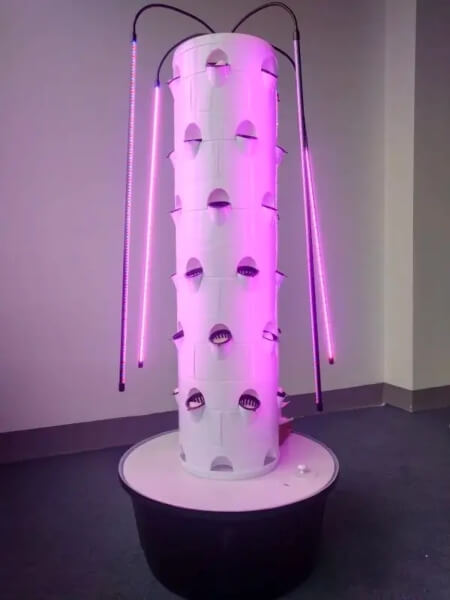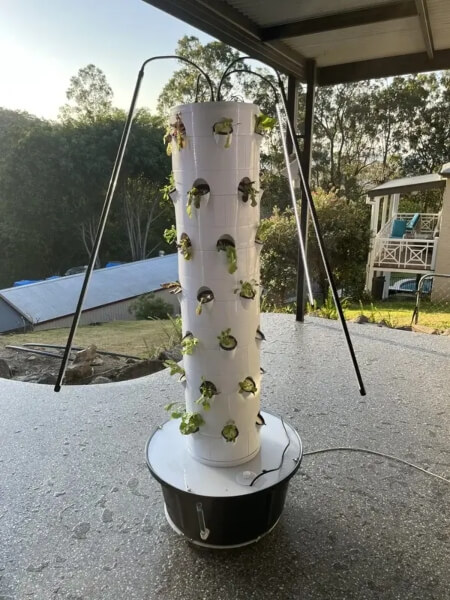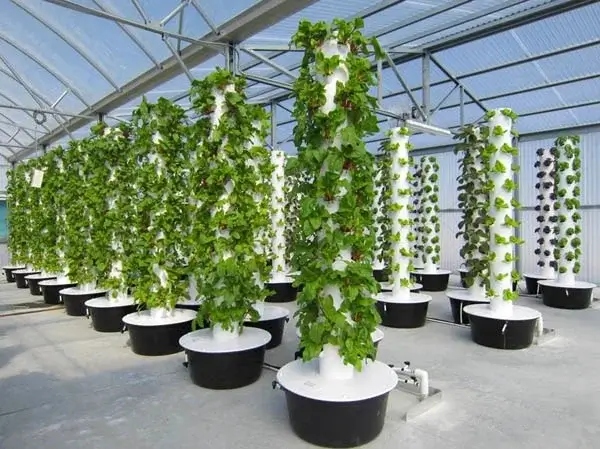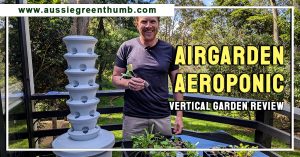Mr Stacky has transformed Australian gardening over the last few years. Their tiered planters, hydroponic systems and drip towers have allowed indoor gardeners and those of us with limited space to grow everything we have ever dreamed of. And they have upped their game again.
The Air Stacky by Mr Stacky is a massive aeroponic drip tower, designed to maximise light and supply clean and constant water and nutrients to any type of plant, but particularly fruits and veggies.
We have been lucky enough to try out the Air Stacky aeroponic tower garden, and have fallen in love.
More...
Introducing the Air Stacky Aeroponic Tower Garden by Mr Stacky

Source: Mr Stacky
The early days of Mr Stacky were a simple adaptation of traditional stacking pots. They offered extra space to grow basic crops like strawberries, and some of the pricier kits had turntables included to maximise sunlight.
Then, they added ingenious hydroponic pumps and reservoirs to those containers, which meant a constant circulation of nutrients and water. The Mr Stacky Hydroponic Kit was one of the first budget-friendly kits like it in Australia, and it is still available for anyone who wants to boost their harvests this year.
Check out our review of the Mr Stacky Hydroponic Smart Farm for more info.
But now, with the rise of aeroponics, dripping moisture through free-hanging roots and massively reducing waste products from growing (including soil and compost entirely), Mr Stacky has made what was once a niche growing technique accessible to everyone. Enter, the Air Stacky!
How does the Air Stacky Aeroponic Tower Garden work?
The Air Stacky aeroponic tower’s inner workings are actually pretty simple, but the results take a bit more explaining… In short, there is a reservoir at the base that pumps water up to the top of the tower, and it drips down, past roots, back into the reservoir.
The longer version is that the reservoir requires topping up with water and nutrients which, when pumped, becomes oxygenated, and supplies everything the growing plants need directly at the roots. Those roots, suspended in nothing but air, constantly self-prune, meaning they are finer roots than in soil and can feed more heavily on the nutrients available.
As the plants develop (they can be started directly in the pods, or planted as seedlings into each of the 42 growing sites) they are also given eight hours of direct full-spectrum UV light from overhead lamps that attach to the tower.
That means you can use the Mr Stacky Air Stacky indoors, outdoors, or move it between the two, with no adverse effects on your crops.
Note: If you have ever taken houseplant cuttings in water, rather than soil, the roots of your veggies here resemble those fine and vigorous roots much more than the thicker roots that occur in soil.
Difference Between Aeroponics and Hydroponics
Aeroponics is a form of hydroponics, not something completely separate. It is a marketing term generally applied to soilless tower hydroponics, but one that is also quite useful.


Get Your Free Guide:
Master Growing Australian Natives eBook
A Must Have Complete Guide for Every Australian Garden
Get Your Free Guide:
Master Growing Australian Natives eBook
A Must Have Complete Guide for Every Australian Garden
Distinguishing between traditional hydroponics (roots in oxygenated water) and aeroponics (roots in air, with dripping water) is useful, because they have different pros and cons.
Namely, aeroponics water needs topping up, not replacing – making the growing process lower maintenance, but it also requires a more constant power supply. Hydroponics can be switched off for 16 hours a day without adversely affecting your plants.
Personally, I prefer the process of aeroponics because it is cleaner, and you get much healthier plants and much, much crisper salad leaves.

Source: Mr Stacky
What to Grow in Your Air Stacky Aeroponic Tower Garden?
Considering that aeroponics is a great way to start cuttings (including hardwood cuttings from fruit trees), it is safe to say that there is no real limit to what you can grow using the Air Stacky.
It is most commonly used to grow things like salads, leafy greens, cucumbers and determinate tomato varieties, but it’s equally good for strawberries, courgettes and even larger veggies like pumpkins or melons.
Potatoes and other tuberous roots like sweet potatoes, Jerusalem artichokes, groundnuts and cassava root won’t work in aeroponics. But, most root vegetables like carrots, beets or parsnips grow well in aeroponics.
What You Get with Your Air Stacky Aeroponic Tower Kit?
When you buy an air Stacky kit you get everything you need to get started, even if you have never used aeroponics before. Below, we will look at what comes with the kit, and its purpose in growing your soon-to-prized harvest.
42 Plant Air Stacky Unit with irrigation components
The main piece of kit is the tower itself, a 1 ft wide plastic tube made for UV-resistant plastic, that stands 1.8m high when fully installed on the base.
The tower is made from eight separate sections, which easily clip together to create a sleek-looking grow tower, with 42 neat pockets to insert each plant. Each section has drainage holes that allow water to sit briefly before dripping, so roots always have access to some sitting moisture before it is replaced by clean moisture a few minutes later.
Grow Lights
Four 18w white LED light strips attach neatly onto the top of the tower and can be set to a simple timer to provide exactly the right amount of light on any day.
Each light strip offers full spectrum light, perfect for every stage of growth and development.
Rolling Base
The 5-wheel heavy-duty base boasts durable double ball bearing caster wheels, which easily take the weight of the tower even with a full reservoir. Not only does it make it simple to move the unit around, but it means you can rotate it regularly if you are growing outdoors and want to make the most of the sunlight with each and every plant.
Pump
The system, as a whole, comes with a one-year warranty, but the pump has an individual two-year warranty if anything ever goes wrong.
The submersible electric pump has a built-in timer and uses minimal electricity to power the simple drip system above, making installation and maintenance easy.
Planting Materials
I love that nearly everything is reusable in the Air Stacky tower, and it is all supplied as standard.
You get 42 grow cups, each with open frames so roots can escape, but tight enough that perlite stays in place for early-stage seedlings. The sponges that hold each plant in place can be washed and reused each time, and the perlite can be reused several times too.
Water Testing Kit
The water testing kit (Hydroaxis EC Testing Kit) helps you to keep an eye on the pH of your water, and adjust it as necessary. If you know your water acidity, and stick to the rules, you will need to use this less as time goes on, but it is a regular purchase you’ll need to make to maintain your tower and the plants in it.
Nutrients
Nutrients can be expensive, but you get more than enough to get you started with a 1 kg bag of powdered nutrients to feed your tower for up to six months.
Thankfully, Mr Stacky offers budget-friendly nutrient packs for when you need them again in future.
How to Install the Air Stacky Aeroponic Tower Garden
There is very little involved in installation, other than clipping together all the components, and filling the grow pots according to the instructions. Some veggies will work from seed in the tower, but most are best planted as young seedlings and allowed to acclimatise.
Once everything is planted up, you can grow indoors or outdoors. Just find a spot with enough space. If it’s bright enough, leave the lights off until winter. If you don’t have much natural light, attach the grow lights and boost your growing conditions instantly.
Air Stacky Aeroponic Tower Garden FAQs

Source: Mr Stacky
What maintenance is involved in the Air Stacky Aeroponic Tower?
Topping up nutrients, and regularly checking water pH levels is essential with any aeroponic or hydroponic growing system. It is also important to maintain the Air Stacky’s general functions by cleaning out pipes and rinsing pump filters every so often.
How do I add nutrients to the Air Stacky reservoir?
The reservoir has a convenient cap where you can test water nutrients and acidity, as well as add powered nutrients to the tank with ease.
Do plants still get pests with the Air Stacky tower from Mr Stacky?
The Air Stacky will not stop some pests, like aphids, from feasting on your plants but it does reduce the chances. Pests are attracted to plants in distress, or overfed plants that they know can cope with infestations. Because aeroponics manages plant health so well, pests are not as common as usual.
Do plants get diseases in aeroponic systems?
The main cause of plant disease and infection with aeroponic systems is poor ventilation. Roots are allowed to dry out between water drip cycles, so they will rarely suffer from fungal problems related to over-watering, and there is no chance of soil-borne pests spreading disease either.
Can you overwater plants with aeroponics?
Aeroponics will not overwater your plants. The entire process is designed to allow roots to dry between drips, so nutrients and water feed plants; they take what they need; and then they process it. By the next time water comes around, roots will have dried off, but not dried out.
Get Your Air Stacky Aeroponic Tower Garden by Mr Stacky Today
Mr Stacky is a pioneer of Australian aeroponics, and the affordability of this new system speaks volumes about their desire to make home-grown veggies accessible to all.
Whether you’re growing your own food for the first time, or looking to scale up a commercial venture and maximise your growing space, Mr Stacky’s Air Stacky aeroponic tower garden is an outstanding piece of garden innovation (and it’s fun to use too).
Published on December 28, 2023 by Nathan Schwartz
Last Updated on September 20, 2024




